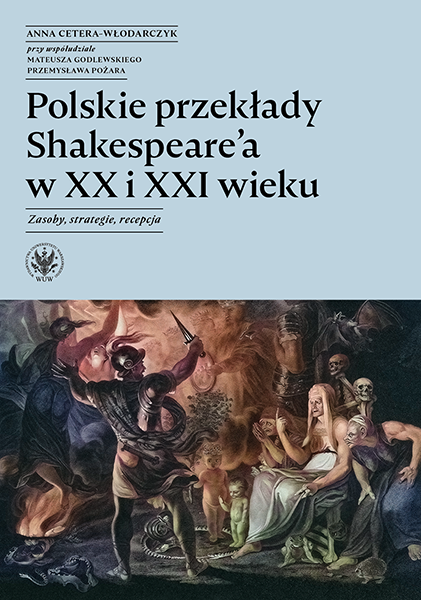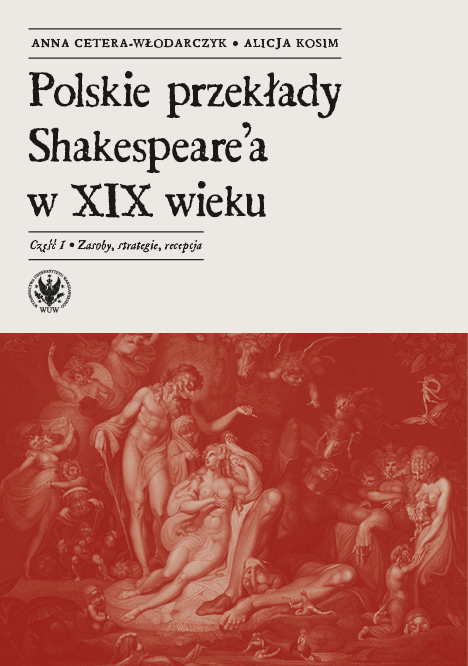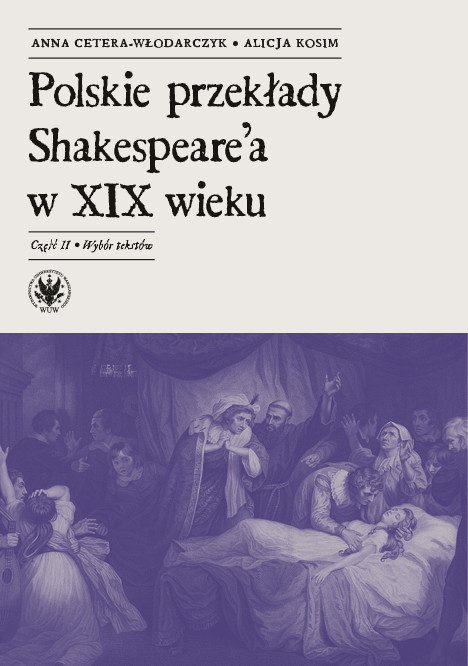Repository of Polish Translations of Shakespeare’s Plays in the 20th and 21th Century: Resources, Approaches, Reception
About the Project
The collection Shakespeare in Polish by UW – 20th and 21st Century Module was created as part of the project A Repository of the Polish Translators of the Drama of William Shakespeare in the 20th and 21st Centuries: Resources, Approaches and Reception (UMO-2017/27/B/HS2/00853), financed by the National Science Centre (Narodowe Centrum Nauki) and completed between 2018 and 2024. This undertaking was the continuation of the earlier project, also financed by the National Science Centre (UMO-2015/17/B/HS2/01784), which resulted in the publication of the collection Shakespeare in Polish by UW – 19th Century Module. The digital archive therefore now holds all Polish translations of Shakespeare.
The goal of the project was to create a collection that, on the one hand, would make all twentieth- and twenty-first-century translations accessible from a single website and, on the other, would provide essays reconstructing the conditions of composition and the reception of the texts. We were interested, in broad terms, in the process whereby foreign literature in translation undergoes assimilation, in all its complexity and with wide-ranging consequences, taking into account changes of fashion, conventions, literary taste and the needs of the theatre, as well as dramatic crises, wars and ideological turning points.
The research findings assembled in this manner are available on the website of the repository Shakespeare in Polish by UW – 20th and 21st Century Module, and also as a digital publication.
There is no doubt that gathering this type of information constitutes only the next step towards broader, interdisciplinary research into Polish translations of Shakespeare and, more widely, into the specificities of the reception of drama in translation, above all the reception of canonical literature over a long period and the associated approaches to retranslation. The project’s genesis was bound up with our powerful conviction that there are significant gaps in our understanding of the phenomena that dominated the reception of Shakespeare after the 19th century. It follows that the creation of a reliable synthesis first requires scrupulous research into the source materials and the identification of the complex, multi-faceted processes that build up a picture of these difficult, unsettled decades.
The starting-point for the project was a reflection on translation studies, particularly descriptive studies of translations that have a methodological focus on the relationship between the translation and the target culture. This consideration entails an awareness of the variability and transience of critical judgements founded on short-lived, normative expectations of what makes, or should make, an ideal translation of Shakespeare. This line of thinking led to an interest in the aesthetic and ideological conditions which, to a great extent, determined the acceptance, suppression or rejection of particular translation projects. The characteristic discontinuity of literary processes and alterations in the structure of state sponsorship – both brought about by global war, the introduction and the rejection of communism, political transformation and changes in the publishing – all this produces an ambiguous picture of the era. The success of particular translations was determined by diverse and unstable factors.
The corpus of Polish translations from the 20th century, and the beginning of the 21st, is large and heterogeneous. Discounting versions only used in theatres, translations of excerpts and those remaining in manuscript form, there are nearly 140 full-length translations published in book form, as individual volumes or, significantly less often, in collected editions. It is not easy to arrange such a corpus systematically, neither with respect to chronology nor location. The place of composition frequently differs from the place of publication. The date of completion, furthermore, sometimes precedes the date of publication by many years. The work-rate of different translators varies hugely: some dedicate only a few months to Shakespeare, others return to their texts and correct them as new editions appear.
Of the twenty-five translators discussed, six translated just a single play. These individual works sometimes enjoyed success on the stage – such as Czesław Miłosz’s Jak wam się podoba (As You Like It) and Wieczór Trzech Króli (Twelfth Night) translated by Stanisław Dygat. Maciej Słomczyński translated all thirty-eight extant plays recognised at the time; Stanisław Barańczak tackled twenty-five; three translators produced more than ten each, namely, Jan Kasprowicz (sixteen), Zofia Siwicka (fifteen) and Jerzy Sito (eleven). Bohdan Drozdowski translated eight plays, as Władysław Tarnawski earlier had done (he left all his versions in manuscript). Three translators still active today continue to add to their oeuvres: Antoni Libera (a total of seven plays by 2023), Piotr Kamiński (six) and Ryszard Długołęcki (five).
UW’s Shakespeare in Polish repository collects all translations from the 20th and 21st centuries.
Users need to log in to access all the translations for research purposes. All translations in the public domain, however, are open access, as are those where permissions have been granted by the translators or their legal heirs. At the present moment, that includes more than eighty percent of the authors from the 19th, 20th and 21st century. In a separate tab there are notes about new translations – individual works that have been published in the last decade, since 2014, whose reception history is so far brief or limited.
Translations from the 20th and 21st century are available as PDF files, as text files created by OCR and also as text files with a basic semantic structure.
The resources can be searched according to given criteria, such as title, translator’s surname, date and place of publication. There are two additional criteria relating to the histories of particular translations: the date and place of composition. The relatively large number of options for searching the database restores historical, geographical and critical dimensions to texts that, for understandable reasons, are somewhat obscured when publications are arranged alphabetically.
The repository also makes available in-depth analysis of the work of all twenty-five translators whose productions were published in the 20th or 21st century. Every translator’s page carries a concise description of their output. A full analysis of each translator (available for download from the same page as a PDF) comprises a biographical essay, a discussion of the translator’s approach and an account of the reception of their work.
The reconstruction of specific translation projects brings to light much information, not previously assembled, about the sociological and psychological conditions in which the translators worked, and also about their mutual connections. The act of translating a Shakespeare play typically goes hand in hand with other literary endeavours. It is much less often an adjunct to another career than was the case in the 19th century. Of our twenty-five translators, only Zdzisław Skłodowski is a lawyer and Ryszard Długołęcki a doctor. The vast majority of the others studied philology or literature (Polish or other modern languages) and for at least part of their career were part of the academy: PhDs were completed by Zofia Siwicka, Stanisław Barańczak, Roman Brandstaetter, Zygmunt Kubiak, Włodzimierz Lewik and Antoni Libera; Witold Chwalewik received an advanced doctoral degree (habilitacja); Jerzy Limon, Władysław Tarnawski and Andrzej Tretiak are all professors, and Shakespeare experts; and Jan Kasprowicz was a professor of Comparative Literature. Czesław Miłosz became a professor in the Department of Slavic Languages and Literatures at the University of California in Berkeley; Stanisław Barańczak occupied a similar position at the Alfred Jurzykowski Department of Polish Language and Literature at Harvard University. A large number of the translators combined their work on Shakespeare’s plays with their own creative writing. Zofia Siwicka was an exception, dedicating herself exclusively to the Bard. The translators took up Shakespeare in all sorts of different circumstances: for some it was the next challenge as they pursued a literary or academic career, particularly in the case of pre-war translators, engaged in new projects for publication or for the stage. Immediately after the war, however, commissions to translate Shakespeare – efficiently and generously remunerated – tempted translators who, as well as being fascinated by the masterpieces in questions, sought a safe space, free from the direct pressure of socialist realism. These were precisely the circumstances, and the motivations, out of which arose the translations of Roman Brandstaetter, Konstanty Ildefons Gałczyński, Czesław Miłosz and, we can assume, Zygmunt Kubiak.
In the following decades Polish versions of the plays appeared specifically intended for the theatre: the work of Jerzy Sito, Krystyna Berwińska and Bohdan Drozdowski went directly to the stage. The theatre becomes a powerful engine for new Polish translations, as well as a context in which the work is appreciated. At the same time, and for the first time in the history of Shakespeare in Polish, the question of determining the value of particular translations takes the translator’s biography into consideration, specifically the issue of bilingualism, supposedly the ideal condition for a translator, guaranteeing the reliability of their work. At the start of the 1970s, the publishing market could rely on a solid stock of existing translations, and any post-war demands on schools and libraries were met by the reissue of canonical, 19th-century translations. The occasional appearance of new translations typically came in the wake of stage productions, rather than preceding them. An initiative by Wydawnictwo Literackie (Literary Press) between 1977 and 1988 proved to be a turning-point. They published a series of translations by Maciej Słomczyński that eclipsed other contemporary translation projects.
The political breakthrough of 1989 brought with it a wave of re-evaluation: writers and their work that had been stymied by the official literary mainstream, available only from the underground press or foreign publishing houses, made their return. This phenomenon, to some extent, applied to translations of Shakespeare: Stanisław Barańczak, whose poetry had been subject to censorship, and who had more or less been forced into exile, in short order shook up and raised the bar of the debate about appropriate and inappropriate strategies for translators of the Bard. Retranslations worked hard to find a home in a literary and theatrical landscape that was already densely populated by their predecessors. As had been the case in the 19th century, a significant proportion of translations were completed abroad: all the plays translated by Stanisław Barańczak and Piotr Kamiński, along with some by Bohdan Drozdowski and Władysław Zawistowski.
Subsections dedicated to the lives of the translators provide basic biographical details, with a particular focus on their educational background, familiarity with foreign languages and knowledge of literature.
The main purpose of giving an account of a translator’s professional career is to shed light on their translation projects. Other literary undertakings are also taken into account, such as creative writing, translating other authors or from other languages, theatre work, research and literary criticism. The opinions of various contemporaries are citied, particularly in the context of Shakespeare in translation. When it comes to figures widely discussed in essays, biographies and critical studies, the facts are referenced to the relevant literature, without detailed analysis of the source materials. In the case of lesser-known translators or figures whose translation has never been the subject of academic research, the subsections give detailed references and sometimes extended quotations from source materials, whether in manuscript or published, previously overlooked by other researchers and accessed specifically for this project.
The subsections on the approach of particular translations refer to two types of sources: the views of the translators and critical analyses of the translations.
Firstly, each translator’s ideas about how to translate Shakespeare are considered, along with their views on other translations, reflections on their own work, their motivation, their experience of working on the text, the critical reaction and the reception in theatre, the material circumstances and finally reasons for interrupting or abandoning a project. Information is also presented about the place, context and development of the translations. The second source is the translations themselves, described in terms of their prosody, techniques, modifications in approach or decisions about including footnotes and commentary. It should be noted that all the translations presented are retranslations: they came into being after the existing canon had achieved stability and they are motivated by the need to update linguistic, literary or theatrical conventions. A characteristic trait of a retranslation is a polemical stance towards its predecessors. They differ in principle from other available and respected translations: in this context it remains a matter of secondary importance whether this difference manifests itself in a rigorous attempt to reproduce the effects of the original or, on the contrary, in a strong (or stronger than before) urge to domesticate the text.
The subsections dedicated to reception include, as far as possible, all recorded opinions on particular translations. Responses from across the lifetime of a text are considered, with particularly attention paid to the first reactions from literary critics or theatre reviewers.
Gathering opinions in this way brings to light changes in the evaluation of translation projects, determined by pressing aesthetic and methodological considerations, and sometimes by personal or political preferences. The subsections give details of all reissues and alterations to the text. A concise account is given of the reception in the theatre, especially where the translation itself is considered. Details of the first production to use a translation are, therefore, recorded, along with the reviewers’ opinions of the text. Select bibliographies of sources are available separately. Sources for all quotations are provided in the essays themselves. Bearing in mind the structure of the repository, with particular sections available on the translator pages, in the footnotes to each essay we always give full biographical details, even when they have already been appended. For this reason, some details are repeated, in instances where the paths of two or more translators cross in a single project.
Existing biographical and bibliographical studies were consulted to create the fullest possible picture of the translation projects. All Shakespearean traces have been scrupulously examined. They were gathered from a variety of sources, in print and manuscript form, held in public and private archives. As far as possible, additional information from reviews and polemical articles has also been taken into account. The images of the past that arise from this research sometimes differ in the way they present events, attitudes and motives. Stories from decades far past, especially those separated from the present by a gap of seventy years, sometimes appear to be more saturated with detail, in terms of emotions, the weight of political events and personal complications. A fuller depiction of these circumstances results from the availability of sources that have survived because of decisions made by their authors and recipients, and the institutions that preserve the documents. It only seems to be the case that we can learn more about more recent times by, on the one hand, making use of the memories of those that were present and, on the other, maintaining the distance and restraint necessary to assess the course of history. We trust, however, that the information gathered here will be a catalyst for other, related research projects, and for researchers from other disciplines. We hope that developments in the digital humanities will significantly accelerate the complex analysis of newspapers and digital archives. It is plain to see – by consulting, for example, the footnotes to the short biographies of translators working in recent years – that the digital humanities are breathing new life into the latest, 21st-century translations of Shakespeare. For the same reasons, we can expect new methods of analysis to appear in treatments of the most recent material, accounts of which are now at large on the internet, leaving none of the material traces of communication typical of recent eras.
The repository Shakespeare in Polish by UW brings up to date knowledge about the reception of Shakespeare in translation in the 20th and 21st centuries. It also facilitates comparative analysis, whether synchronic or diachronic. It does not, however, encourage the passing of judgements.
On the contrary, an understanding of how the same translation projects are perceived differently over the course of years, decades, even centuries, leads to caution. On closer inspection, the way we picture translators and their projects becomes more complex. We see more clearly the influence of opposing literary currents, the instability of critical judgements, the density of the historical record and the force of stirred emotions. When translations are assembled in a single location, they become subject to the electronic compression of epochs and styles. They then benefit in turn from the virtual democratisation of resources. Regardless of the individual story, the number of preserved copies, the generosity or otherwise of the critics, all the translations respond in the same way when summoned by the keyboard. The new digital life of the archive gives new meaning to the efforts of the translators, whose work becomes a unique mirror of different times and places.
Anna Cetera-Włodarczyk
Electronic publications

Anna Cetera-Włodarczyk, Mateusz Godlewski, Przemysław Pożar, Polskie przekłady Shakespeare’a w XX i XXI wieku. Zasoby, strategie, recepcja, Warszawa: Wydawnictwa Uniwersytetu Warszawskiego 2024.
Previous electronic publications

Anna Cetera-Włodarczyk, Alicja Kosim, Polskie przekłady Shakespeare’a w XIX wieku. Część 1. Zasoby, strategie, recepcja, Warszawa: Wydawnictwa Uniwersytetu Warszawskiego 2019

Anna Cetera-Włodarczyk, Alicja Kosim, Polskie przekłady Shakespeare’a w XIX wieku. Część 2. Wybór tekstów, Warszawa: Wydawnictwa Uniwersytetu Warszawskiego 2019
Citing
Anna Cetera-Włodarczyk, About the Project [w:] Polski Szekspir. Repozytorium polskich przekładów Szekspira w XX i XXI wieku: zasoby, strategie, recepcja [online], Uniwersytet Warszawski, https://xx.polskiszekspir.uw.edu.pl/project, 2026-01-21.
